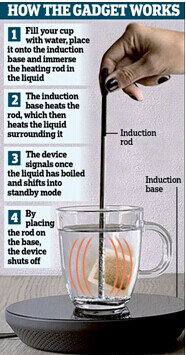
It happens to us all – you fill up the kettle to make a quick cup of tea, and then have to wait ages for it to boil. But that frustration could soon be a thing of the past with a device that heats the exact amount of water you need for your cup...by boiling it in the mug.
This means that not only does the device save time, it also saves energy. To heat water, a mug is placed on a special induction(感应)plate and a magnetic
(磁性的)metal rod is immersed in it. The base creates an electromagnetic field that causes the water around the rod to heat up. And if you have guests over and want to make more than one cup – just place your teapot on the device, called a Miito, and it works in the same energy-efficient way.
The Miito is the brainchild of Nils Chudy and Jasmina Grase, former students of the Design Academy Eindhoven in the Netherlands. They set out to redesign the kettle after realizing the amount of energy that’s wasted each time it is put on to boil and hailed Miito as an “innovative product that reduces the heating of excess water”.
Mr Chudy, 23, from Berlin, Germany, said: “Miito all started with looking at electric kettles. While researching electric kettles more closely, we noticed that there was a major design flaw(瑕疵). They are extremely wastefully designed – the minimum fill line of the majority of kettles is at approximately 500mL which means that if you want one cup of tea, around 250mL, you waste 50 per cent of the hot water.
“We set out to redesign the electric kettle to change people’s habits of overfilling electric kettles in order to save energy. Miito is efficient because you only heat the amount of water you need saving time and energy.”
The pair is now looking at ways of mass-producing their kettles, and hopes to sell them for around £80 once they hit the shelves.
本时文内容由奇速英语国际教育研究院原创编写,禁止复制和任何商业用途,版权所有,侵权必究!
1.What do we know from the first paragraph?
A It takes a long time to boil water.
B We boil the exact amount of water to drink.
C We have a short time for tea.
D We will no longer use a kettle to boil water.
解析:选D。D 细节理解题。根据文章第一段…that frustration could soon be a thing of the past可知,Miito的发明将使电水壶成为历史,人们不会再为等一壶热水费心劳神。
2.How does Miito work to heat water?
A The moment the rod is put into the pot water begins to heat up.
B The magnetic metal rod in pot causes the water to heat up.
C The special induction plate causes the rod in the pot to heat up water.
D An electromagnetic field causes the water around the rod to heat up.
解析:选D。D 细节理解题。根据文章第二段The base creates an electromagnetic field that causes the water around the rod to heat up可知,感应盘产生电磁场,通过金属杆给水加热。
3.What was the major design flaw of electric kettles?
A 50 per cent of hot water is often wasted.
B The minimum fill line is about one cup of water.
C They are often overfilled and waste energy.
D Kettles only contain around 250ml of water.
解析:选A。A 细节理解题。根据文章第四段…you waste 50 per cent of the hot water可知,电热壶容量过大,加热时间长,热水用不了,约有一半的水被浪费掉—这就是电热壶的设计缺陷。
4.What is implied in the passage?
A A Miito heats up water more quickly than an electric kettle.
B Miito is sure to be very popular as it saves a lot of energy.
C People will change their habit of using electric kettles.
D A Miito heats up water the same way of an electric kettle.
解析:选B。B 推理判断题。根据文章最后一段…looking at ways of mass-producing their kettles可知,发明者正在准备批量生产这种加热器。结合人们的环保节能意识判断,Miito推向市场后,将深受人们的欢迎。
5.What can be the best title of the passage?
A Electric Kettles Will Disappear in Our Life.
B Young Inventors and Their Innovative Product.
C Kettle-like Device Saves Much Time and Energy.
D Electric Kettles Waste Much Water and Energy.
解析:选C。C 主旨大意题。通读全文可知,本文的主要内容是介绍一款节能电磁壶Miito。故选C。